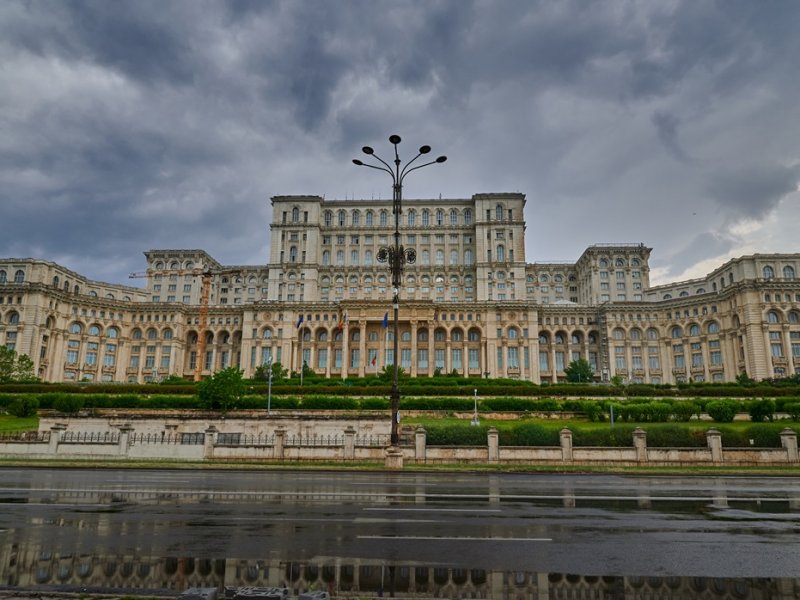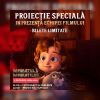Uranus, the vanished neighborhood of old Bucharest. What once stood where the People's House—now the Palace of the Parliament—rises today

By Bucharest Team
- NEWS
- 21 JUL 25
Before the Palace of the Parliament came to dominate Bucharest’s skyline, the area it now occupies was home to the Uranus neighborhood—a charming district of cobbled streets, elegant houses, and an atmosphere that reflected the soul of old Bucharest. It was a middle-class community, inhabited by merchants, artisans, and small business owners. The architecture showcased the taste of the era: carefully built homes, some designed by renowned architects.
Steep and narrow streets, stone-paved roads, trams climbing the hill, the A.N.E.F. stadium, and the cozy restaurants that enlivened the neighborhood all contributed to a distinct urban identity. Former residents speak fondly of Ecoului Street, of winters spent sledding, and of the tight-knit community that defined the spirit of the area. These memories have been preserved through interviews and urban research projects aimed at keeping the essence of this lost neighborhood alive.
The demolition of Uranus and Ceaușescu’s grand vision
Starting in the late 1970s, the communist regime launched a sweeping process of urban systematization, accelerated by the 1977 earthquake. Nicolae Ceaușescu saw the disaster as an opportunity to implement his vision for a new political and administrative center—one heavily inspired by North Korean models. Uranus was among the first areas targeted.
Demolitions began in 1981 and continued until the regime's fall in December 1989. Entire streets, homes, gardens, and significant landmarks such as the Brâncovenesc Hospital, the State Archives, and dozens of churches were erased. Among them, Mihai Vodă Monastery was famously moved and concealed behind apartment blocks. In total, more than 10,000 homes were demolished, displacing around 50,000 people who were relocated to high-rise buildings.
Today, while the Palace of the Parliament stands as a powerful symbol of Bucharest, it rises on the ruins of a vibrant neighborhood, almost entirely erased from the city’s physical landscape.
Traces of the old city still survive
Even now, in the areas around the Romanian Academy Library and along 13 Septembrie Avenue, fragments of the former Uranus neighborhood can be found: pieces of old cobblestones, trees that survived the clearing, and isolated homes stranded in vast open spaces. These remnants—what some architects call "urban fabric edges"—are vital in reconstructing the city’s lost identity.
Architect Ștefan Ghenciulescu, who has extensively studied Bucharest’s transformations during communism, stresses the value of these traces. “It’s not just a history that has vanished—it lingers, often in uncomfortable forms. But these remnants can form the foundation of a symbolic process of urban memory reconstruction,” he explains.
Overlay projects that map the old and new versions of Bucharest help the public understand how drastically the city’s structure was altered. In this way, the past remains accessible—even if it’s no longer visible on the surface.
A history of demolitions
Though Ceaușescu’s regime is most strongly associated with mass demolitions, the idea of reshaping the city by erasing its past did not begin with him. As early as the 19th century, Romanian authorities had already demolished churches and old buildings to make way for modern institutions. King Carol I was considered one of the most aggressive “demolishers” of churches, as the newly formed Romanian state demanded space for its civic ambitions.
However, there’s a fundamental difference between the two eras: in the 19th century, the concept of “historic monuments” was still in its infancy, and heritage preservation was not clearly defined. By contrast, the demolitions of the 1970s–80s took place at a time when such actions were widely condemned in most civilized countries.
The memory of a vanished neighborhood
Despite the massive destruction, the memory of the Uranus district persists—through the stories of its former residents, the few surviving fragments, and the work of architects and researchers determined not to let this piece of Bucharest’s soul fade into oblivion. Though physically erased, Uranus remains a symbol of the lost city, a poignant reminder of how history can be wiped out—but not forgotten.
Today, when we look at the People’s House, it’s important to remember that beneath this monumental structure lie not just concrete foundations, but the remains of a neighborhood filled with life, families, streets, and a vibrant urban rhythm that once shaped the capital’s identity.
Uranus Now
Uranus is not just a page from history—it is a lesson in how the past can be sacrificed for political ambition, and how difficult it is to reclaim what has been lost. Three specialists—Ștefan Ghenciulescu, Dorothee Hasnaș, and Ilinca Păun-Constantinescu—have worked to restore the imagery of those times through a remarkable project titled Uranus Acum (Uranus Now).
In its first stage, the project involved extensive historical and architectural research, resulting in a digital archive dedicated to the Uranus–Izvor area, bounded by Splaiul Independenței, Piața Constituției, Piața Regina Maria, Calea Rahovei, and Strada Izvor. The archive includes historical and contemporary photographs, urban plans, excerpts from previous studies, and interviews with former residents and witnesses of the area's transformation. Based on this material, a 3D digital reconstruction was created—offering a dual perspective: one showing the district before its communist-era demolitions, and another illustrating its current urban layout.


























